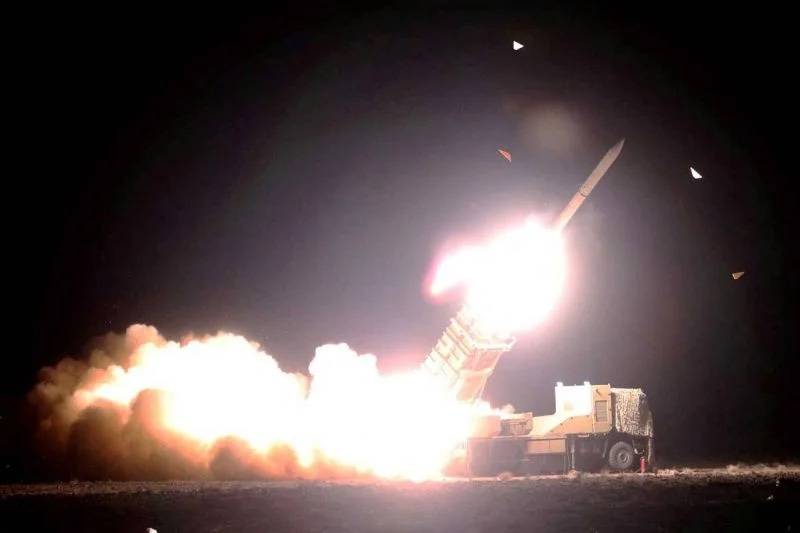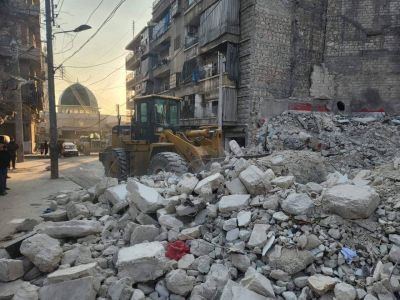
An Iranian missile launched during a military exercise in Iran. (Credit: Reuters file)
Rarely has a visit by the International Atomic Energy Agency (IAEA) general director been surrounded by so much concern. Rafael Grossi’s latest trip to Iran, where he arrived on Friday, took place in a context of acute tension.
The alert leaked to the press before being confirmed by the IAEA’s quarterly report. Particles of 83.7 percent enriched uranium were discovered by the agency’s inspectors at the Fordow enrichment plant — close to the estimated 90 percent threshold needed to build a nuclear weapon and above the 3.67 percent limit established by the 2015 Iran nuclear deal. The US’ withdrawal from the deal in 2018, under then-President Donald Trump, prompted Iran to leap forward with its program.
Citing “unintended fluctuations” during the enrichment process, Mohammad Eslami, the director of the Atomic Energy Organization of Iran (AEOI), spoke last Wednesday of an almost invisible particle, “even under a microscope.” This was not enough to reduce concern.
Tehran can produce enough fissile material for a nuclear bomb “in 12 days,” US Undersecretary of Defense for Policy Colin Kahl said in a statement on Feb. 28. While the US and Israeli intelligence agencies estimated that Iran would need another two years to build a nuclear weapon, Israel has nonetheless raised its level of readiness for strikes against Iranian nuclear sites.
This prospect could be accelerated by rumors of Tehran’s upcoming acquisition of S400 air defenses from Russia, in exchange for the Iranian-made drones used by Moscow in its war in Ukraine.
At a time when Iran seems to have never been so close to obtaining a nuclear weapon, which it firmly denies, we speak with William Alberque, an expert focusing on preventing the proliferation of nuclear weapons at the International Institute for Strategic Studies.
Does the discovery by IAEA inspectors of uranium particles enriched to nearly 84 percent at the Fordow site mean that Iran will soon be able to build a nuclear weapon?
The principle of enrichment consists of transforming natural uranium into its isotope 235. Centrifuges such as the Fordo plant make it possible to separate uranium-235 from the rest. Obtaining low-enriched uranium, from 0 to 3.67 percent [necessary for a nuclear reactor], requires a lot of time and effort.
But the most important part of the work consists of going from 3.67 percent to 20 percent, or highly enriched uranium. From there, it becomes much easier to enrich it to 60, or even 80 and 90 percent.
What do these numbers mean? Let’s say that at 60 percent, one starts to be able to build a bomb, but it’s still very difficult. But at 80 percent, it’s something else. The first atomic bomb, Little Boy, which the US dropped on Hiroshima in 1945, was mostly made of 80 percent enriched uranium.
The IAEA report at the end of 2022 revealed that Iran had more than 60kg of uranium enriched to 60 percent. Whenever they want, the Iranians can enrich this uranium to 80 or even 90 percent and obtain enough fissile material to make two bombs.
As for the 84 percent, while it is possible that this is just a sample, I think the Iranians are experimenting to see how far they can enrich the uranium. Now their centrifuges are at least five times more powerful than they were when the Iranian nuclear deal came into effect. Added to this is the problem of the IAEA’s lack of access to inspect some enrichment sites where the cameras have been cut off. All in all, this is a very disturbing signal.
With a sufficient stockpile of enriched uranium to produce a nuclear weapon, what would be the next steps in making the bomb, and does Iran possess the technical capacity to do so?
Once uranium is enriched, it must first be converted into a type of black powder before being transformed into metal, which is the optimal form for making a bomb.
It is known that Iran conducted experiments with the “metallization” process before 2003 [which is when Iran claimed to have ended its nuclear activities of a military nature, according to CIA Director William Burns in an interview with CBS News on February 26, 2023. Burns also stated that Iran has not resumed these activities].
In 2022, Iran reportedly experimented with the transformation of 60 percent enriched uranium into metal. Furthermore, prior to 2003, Iran had already designed a nuclear warhead. Tehran also possesses missiles capable of carrying these warheads.
The time it takes to make a nuclear bomb is highly complex and requires a significant amount of technical expertise and resources. While in 1945 it took the Americans four months to go from 80 percent enriched uranium to a bomb, today’s technology is significantly more advanced. The computer at the time was less powerful than our smartphones today.
If Iran were to produce two nuclear warheads, it may take fewer than four months.
Tehran has consistently denied the military nature of its nuclear program, but what are the potential civilian uses for uranium enriched at 60 or 90 percent?
While it’s true that enriched uranium is more efficient for civilian activities, it’s not always necessary. Since former President Barack Obama came to power, the United States has been urging states to use the least amount of enriched uranium possible for their civilian needs.
Iran currently possesses more than 60 kilograms enriched to 60 percent, making it hard to argue that this amount is intended for purely civilian purposes. So why does Iran persist in claiming this?
The American withdrawal from the Vienna agreement has created a dangerous and harmful spiral where Iran feels the need to continue enriching uranium to gain international attention. This vicious cycle could justify military strikes from the US or Israel, and we must work to break it as soon as possible.
Despite the nuclear deal being considered “frozen,” US Undersecretary of Defense Colin Kahl recently stated that diplomacy remains the best option. Tehran also appears to be willing to return to the negotiating table.
With talks stalled since last summer, can the recent IAEA findings help revive the discussions aimed at reactivating the Vienna agreement?
The Vienna agreement is not just frozen, it is completely dead. However, no one is willing to declare it as such, as no one knows what to do with its remains. The debate surrounding the agreement has become so politically poisoned, with Iran’s involvement in the war in Ukraine and its suppression of the Iranian protest movement (which emerged following the death of Mahsa Amini on Sept. 16), that even the mere prospect of negotiations between the US and Iran seems to be driving everyone crazy.
What’s necessary is for the West to engage in secret negotiations with the Iranians and present them with an ultimatum: “Choose a ceiling stockpile of 60 percent enriched uranium, stick to it, and dismantle your centrifuges.”
This would shift the responsibility to Iran and turn the situation around.
Currently, Iran has an interest in escalating, and the West has responded with pressure, which could potentially lead to war. Therefore, it's crucial to incentivize Tehran to adopt a ceiling on enriched uranium, convince Israel and the Gulf states to accept it and provide Tehran with security guarantees in exchange.
If these secret negotiations fail to materialize, is it possible that the shadow war between Iran and Israel could escalate into open armed conflict, despite the US’ reluctance thus far?
The problem with hardline politicians is that they often raise the prospect of conflict to demonstrate their strength to their electorate. Benjamin Netanyahu, for example, could be caught in his own rhetorical trap and end up fighting a war that works against his interests. For instance, if Israel were to bomb the Fordow plant, Tehran likely has spare centrifuges and would continue its activities even more covertly.
Iran’s nuclear program is a complex issue that can only be resolved through political means. War is not a viable solution, and a mere agreement would only provide temporary relief before real negotiations can emerge.
However, envisioning and demonstrating political courage for such talks requires imagination and political courage. Unfortunately, it appears that current regional decision-makers are more inclined toward provoking conflict than pursuing peace.
This interview was originally published in French in L'Orient-Le Jour. Translation by Joelle El Khoury and Sahar Ghoussoub.
